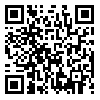Volume 18, Issue 6 (2018)
MCEJ 2018, 18(6): 169-180 |
Back to browse issues page
Download citation:
BibTeX | RIS | EndNote | Medlars | ProCite | Reference Manager | RefWorks
Send citation to:



BibTeX | RIS | EndNote | Medlars | ProCite | Reference Manager | RefWorks
Send citation to:
Ghassemieh M. Evaluation of End-Plate Moment Connection Subjected to Combined Loading. MCEJ 2018; 18 (6) :169-180
URL: http://mcej.modares.ac.ir/article-16-16102-en.html
URL: http://mcej.modares.ac.ir/article-16-16102-en.html
Mehdi Ghassemieh *  1
1
 1
1
1- Professor of Structural EngineeringSchool of Civil EngineeringUniversity of Tehran
Abstract: (5923 Views)
This study investigated the effect of combined loading on end-plate moment connection considering the interaction of bending moments, axial forces and twisting moments. In some cases, beam-to-column joints can be subjected to the simultaneous action of bending moments, axial forces and twisting moments. Current specifications for steel joints do not take into account the presence of axial forces (tension and/or compression) or twisting moments in the joints. Although the axial force or twisting moments transferred from the beam is usually low, it may, in some situations attain values which can lead to a considerable effect on the connections behaviour and significantly reduce the joint flexural capacity. Unfortunately, few studies considering the bending moment versus axial force interactions have been reported and there aren’t any reports considering bending moments versus twisting moments interactions or combination of all the mentioned cases of loads at the same time. The lack of knowledge for understanding the performance of end-plate moment connection under combined loads may lead to unreasonable or even unsafe design. Thus in this study a combination of different loads being applied simultaneously on the end-plate moment connection have been examined. Therefore two extended End-Plate connections with different behaviour modeled using finite element method of analysis. The interactions between connection components (bolts, members and endplate) were accurately modelled to simulate the actual behaviour of connections. Material nonlinearity as well geometric nonlinearity were considered in the analysis including the effect of contact. At first the behavior of the end-plate models are investigated in pure bending application. The numerical results were validated against experimental data. Due to the lateral loads and because of the existence of axial force in the moment resisting frames, the combination of bending and axial force in beams should be considered. An example of having bending and axial action is when the structures are subjected to fire which the effects of beam thermal expansion and membrane action can induce significant axial forces in the connection is a common condition. The results show that even in small amount of axial force the mode of failure and moment capacity of connection can change. Axial tensile forces decrease the initial stiffness of connection and axial compressive forces increase the stiffness. In many applications beams are eccentrically loaded and as a result experience twisting loads in combination with bending. The interaction effects due to torsion acting in combination with bending can reduce the capacity of the beam and initial stiffness of connection. Finally axial forces were added to the previous models so they experienced a combination of axial force, bending and twisting moment. The results indicated that the level and direction of axial force significantly modified the connection response. It was observed that compression forces significantly decrease the bending capacity of the models and lateral-torsional buckling of beam occures in all models. Tension forces can reduce the effect of torsion and in many cases they caused the bolts ruptured. Moreover, interaction diagram for predicting the bending capacity considering interaction of bending, torsion and axial forces are proposed based on the results from finite element analysis.
Article Type: Original Manuscript |
Subject:
Earthquake
Received: 2017/08/22 | Accepted: 2024/01/2 | Published: 2019/03/15
Received: 2017/08/22 | Accepted: 2024/01/2 | Published: 2019/03/15
| Rights and permissions | |
 |
This work is licensed under a Creative Commons Attribution-NonCommercial 4.0 International License. |






